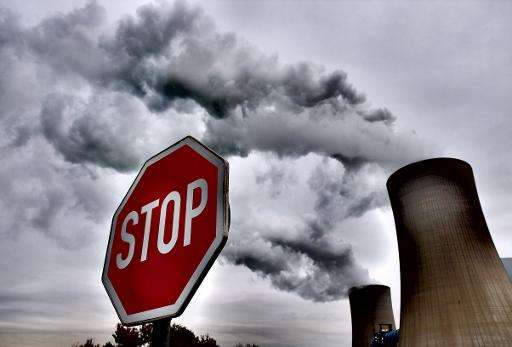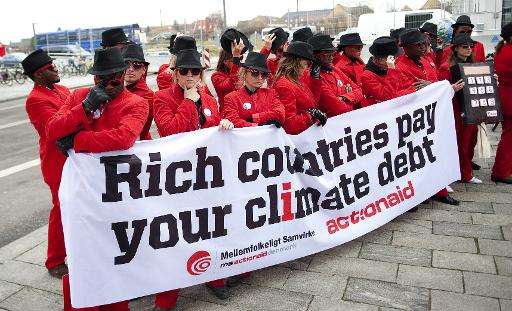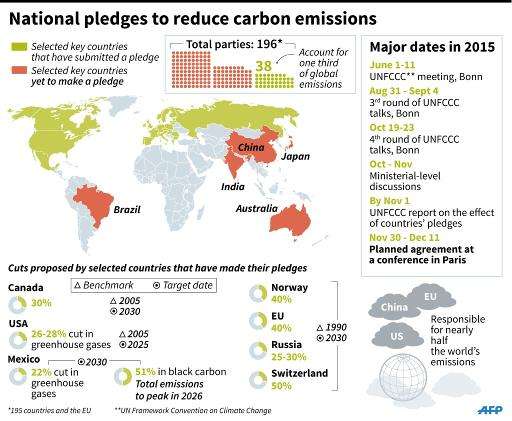Path to 2 C emerges as thorn at climate talks

The world community has rallied around the goal of limiting global warming to two degrees Celsius (3.6 degrees Fahrenheit), but how to get there is becoming a headache.
One of the many knots to untangle at UN climate talks is whether to set a trajectory for reaching 2 C—and if so, how.
Some countries say the 2 C goal itself is too vague, and needs to be buttressed by a long-term ceiling for greenhouse gas emissions.
"It would be clearer and more concrete than 2 C. But it's a tough issue," says French negotiator Laurence Tubiana, whose country will host the November 30 to December 11 UN parlay in Paris where the pact is set to be sealed.
The idea of a pathway first arose in 2009 at the UN climate summit in Copenhagen, where a small group of leaders, desperate to avoid a fiasco, cobbled together an agreement setting a 2 C target.
It was only the following year that members of the UN Framework Convention on Climate Change (UNFCCC) endorsed the goal.
Negotiators also specified the limit be set against a benchmark of temperature before the Industrial Revolution, when coal began to be burned in big quantities, followed by gas and oil.
But important stepping stones for reaching 2 C have not yet been put in place.
And the mood in Bonn, at the halfway point in an 11-day round of pre-Paris talks, shows how problematic the issue is.
The UN's Intergovernmental Panel on Climate Change (IPCC) says that on current emissions trends, the planet could be up to 4.8 C warmer by 2100, which would drive an increase in hunger, floods and homelessness.

For a good chance of attaining the 2 C limit, global annual carbon emissions must fall by 40 to 70 percent by 2050 compared to 2010 levels—and to zero or below by 2100, the IPCC says.
Translating the requirements of science into political language that satisfies 195 nations, including highly climate-vulnerable states and major users or producers of fossil fuels, is a big ask.
Several options for the draft accord are being booted around.
Small-island states are calling for carbon emissions to peak as soon as possible to limit warming to 1.5 C, a safer but far tougher goal.
European nations, meanwhile, want a reduction of at least 60 percent by 2050 over 2010 levels.
"If countries really want to show that they are moving out of fossil fuels, as the IPCC recommends, they have to set a target for 2050 and a deadline for reaching zero emissions," says Alix Mazounie, a French activist with the Climate Action Network (CAN).
But, as a European negotiator acknowledged, "the problem with setting a precise figure is that it opens up the question over who does what to get there.
"Any attempt to calculate national (carbon-cutting) contributions for 2050 will be a surefire failure."

Textual trap?
But sketchier objectives may also be unacceptable.
Big fossil-fuel exporters Saudi Arabia and Australia, for instance, are against anti-oil and anti-coal terms such as "decarbonisation" of the economy.
"Net zero emissions by 2100," an idea supported by the United States, Canada and Japan, seems to be making headway in some quarters, but not others.

"Adding 'net' to a goal of 'zero emissions' may prove to be a trap," British campaign group ActionAid says.
The term may empower countries to count carbon-absorbing forests and farmland towards emissions offsets, rather than actively curb the pollution, it said.
With just three words, the UNFCCC "could drive devastating land grabs and hunger through the large-scale use of land, biofuels and biomass to absorb rising carbon dioxide emissions", ActionAid warned.
© 2015 AFP




















